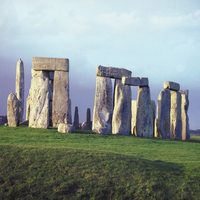Stonehenge

One of the most amazing monuments in England is Stonehenge. These days most people cannot enter it, but when I first saw it as a teenager in the early 1970s you could still go inside, and it was one of the places that I was taught to dowse. The power of the place has undoubtedly risen with its fame and mystery, but the fact remains that most sensitive people are quite strongly affected by it.
Some of the stones were probably brought from South Wales and the entire Stonehenge complex was built in several construction phases spanning
about 2,000 years, although there is evidence for activity both before and
afterwards on the site. There was a wooden henge of the site long before the stones arrived.
The BBC is reporting that archaeologists have discovered a huge ancient settlement used by some of the people who built Stonehenge.
Excavations at Durrington Walls have uncovered remains of ancient houses. People seem to have occupied the sites seasonally, using them for ritual feasting and funeral ceremonies.
It is thought that in ancient times, this settlement would have housed hundreds of people, making it the largest Neolithic village ever found in Britain. The dwellings date back to 2,600-2,500 BC – according to the researchers, the same period that Stonehenge was being built or re-built.
Mike Parker Pearson from the University of Sheffield, said, “In what were houses, we have excavated the outlines on the floors of box beds and wooden dressers or cupboards.”
The researchers have excavated eight houses in total at Durrington. But they have identified many other probable dwellings using geophysical surveying equipment. They think there could have been at least one hundred houses, each measuring about 5m (16ft). They are square, made of timber, with a clay floor and central hearth. The archaeologists found 4,600-year-old rubbish covering the floors of the houses.
And archaeologists love rubbish!
The evidence suggest that Stonehenge drew Neolithic people from all over the region, who came for massive feasts in the midwinter where they consumed prodigious quantities of food. The bones were then tossed on the floors of the houses.
Durrington has its own henge made of wood, which is strikingly similar in layout to Stonehenge. It was discovered in 1967.
Both henges line up with events in the astronomical calendar – but not the same ones. Stonehenge is aligned with the midwinter solstice sunset, while Durrington’s timber circle is aligned with the midwinter solstice sunrise. So it would seem that they were complementary.
Stonehenge lies on an extraordinary system of ley lines that crisscross the British Isles, parts of Northern France and parts of China. The lines are usually dismissed as pseudoscience, and it is certainly sometimes difficult to follow what some writers have to say on the subject. There is also a small body of evidence that some people can sense these ley lines. For people who can, the sensation is much the same as feeling the acupuncture meridians of the body. This apparent similarity has lead some experts in Feng Shui to approach personal wellness in the same way that they recommend the placement of plants, mirrors and other objects. Both the body and the land are looked at like gardens that need to be cultivated.
With some people, where they live, how they lie in bed and where they are treated can all be affected by these lines. Others don’t seem to notice a thing. I was once treating a lawyer with insomnia, and things were not going well. Until she went on vacation to England and she was fine for a couple of weeks. On her return to the USA we just moved her bed and the problem was solved. I just wish that it were always that easy!
It took me a long time to be persuaded that what I and others felt at Stonehenge and along these lines was real and not just make believe. But now I am convinced. The Ancients knew something about the relationship of the land to their lives, and we are finally recovering some of that knowledge for ourselves.






